Thread: Project Sebring GT Spyder
-
02-19-2017 07:57 PM #151
While I was back on the rear suspension, I went ahead and rebuilt the Watts link brace. I had to remove it when I was fitting the exhaust due to interference. The original brace was made of 1 1/4" square tubing. I looked at modifying the original frame, but decided to just start over. Snaking the tubing around the exhaust was going to be difficult and would have looked odd when done, so I thought I would explore other options.
Because this car is so compact (and crowded) underneath, I made as many parts bolt in as possible to make future servicing a lot easier.
I made the new brace from a piece of 1/4" 6061 aluminum plate I had. I don't have any pictures of the cutting. I didn't think a mill covered in aluminum shavings would be very interesting. The frame end mounts are steel and they will serve double duty as a place to mount the rear sway bar. Both halves of the brace are same. At least it adds a little symmetry to this thing, since the Watts link forces most of the parts to be asymmetrical.
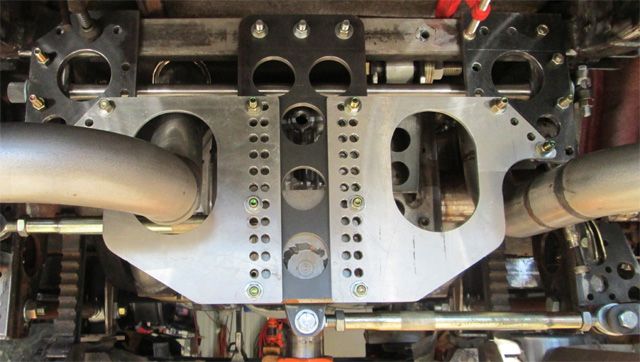
-
Advertising

- Google Adsense
- REGISTERED USERS DO NOT SEE THIS AD
-
02-20-2017 12:33 PM #152
- Join Date
- Apr 2011
- Location
- Prairie City
- Car Year, Make, Model: 40 Ford Deluxe, 68 Corvette, 72&76 K30
- Posts
- 7,301
- Blog Entries
- 1
Very nice work on those pieces!Ryan
1940 Ford Deluxe Tudor 354 Hemi 46RH Electric Blue w/multi-color flames, Ford 9" Residing in multiple pieces
1968 Corvette Coupe 5.9 Cummins Drag Car 11.43@130mph No stall leaving the line with 1250 rpm's and poor 2.2 60'
1972 Chevy K30 Longhorn P-pumped 24v Compound Turbos 47RH Just another money pit
1971 Camaro RS 5.3 BTR Stage 3 cam, SuperT10
Tire Sizes
-
06-10-2017 12:58 PM #153
I thought it might be time for another series of updates. I've been working pretty hard on the car and just don't seem to have time to get the updates done. Most of these posts will be of work that's been completed for quite a while. Sorry.
Next up is the rear sway bar. Like a lot of other suspension areas on this car, I wanted as much adjustment here as I could get for tuning. My original plan had been to mount the bar under the rearend on the Watts link brace. Once again, I was foiled by the asymmetrical arms on the Watts. I was forced to put it in the only place that there was room and that was near the top of the brace.
I looked at adapting or modifying sway bars from other cars, but didn't come up with anything that looked promising. I did pick up a couple from swap meets and the salvage yard, but wasn't satisfied with them.
I researched making my own. I found a lot of info in the books I had and on the net with all the calculations, but most sources recommended heat treated steel. Some commercial bars were listed as being 4130, but whether they are heat treated or not is anyone's guess.
Making a bar wouldn't be too difficult, but getting it properly heat treated would be. I have access to a small heat treat oven, but it is tiny. No way I could rig something up that would give consistent results on something as long as a sway bar.
To have a good shot at properly heat treated spring steel bar, I used a mini sprint car torsion bar. They are available in different diameters and the arms attach with splines. The splines come in standard OD's so that one set of arms can be interchanged with several bars. Not the cheapest option, but workable for a good quality sway bar. This isn't my idea and has been done by a lot of other people. A similar setup is used for NASCAR sway bars. The NASCAR parts are purpose built for sway bars, though.
-
06-10-2017 01:02 PM #154
Like the new upper shock mounts, I reshaped a piece of tubing for most of the sway bar bearings. I bored some DOM tubing out to accept the Delrin bushings. I could have made the bushings too, but at around $2.00 apiece, it didn't seem worth the time. I didn't see the need for a split pillow block type bearing like I see a lot of people using. They are a lot of trouble to make and since the arms come off these bars, the bar can just be slid out the end.
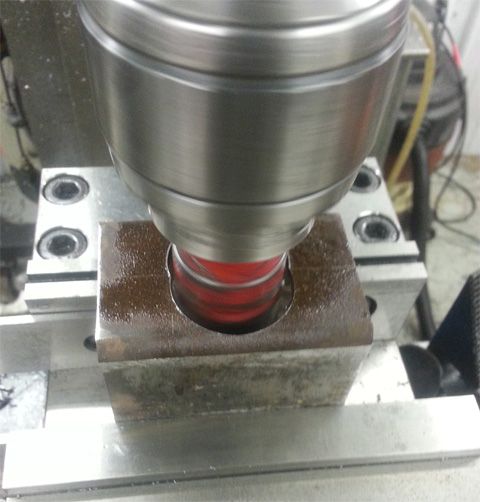
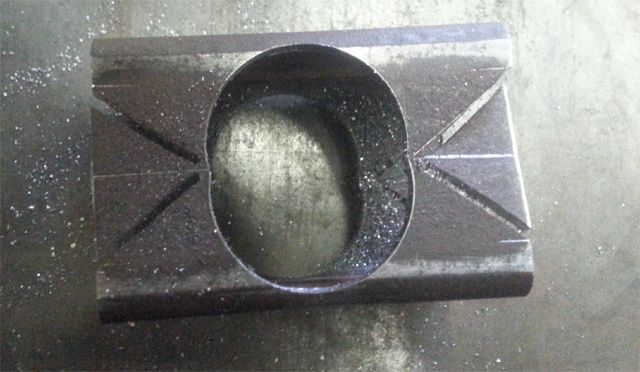
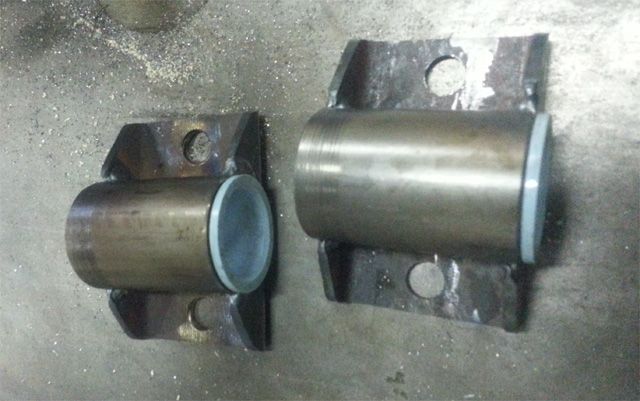
-
06-10-2017 01:05 PM #155
Along with the bar I bought some splined aluminum arms made for them, but they were just too bulky to fit on the rear. I shortened them and cut some bolt-on arms out of steel. I still have a small interference issue, but that will be solved when the body comes off. There's just no room to work with the body on. The arms have several adjusting holes in them. By moving the links, the arm can be shortened or lengthened. This changes the effective rate of the sway bar. When the rearend comes out next time, I'll add some adjusting plates with similar holes to the axle tubes for the lower end of the links to attach to.

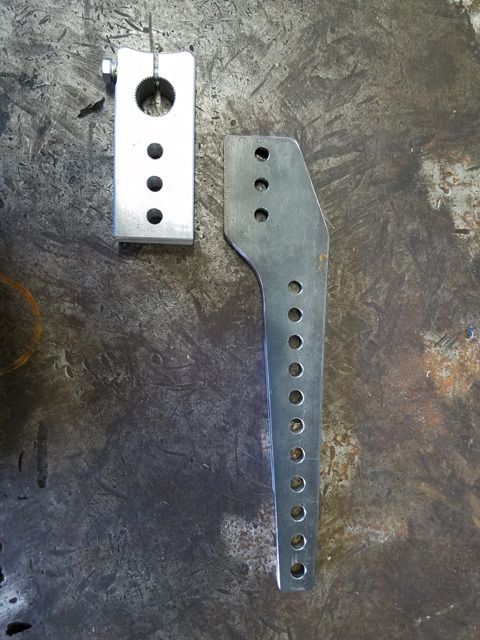
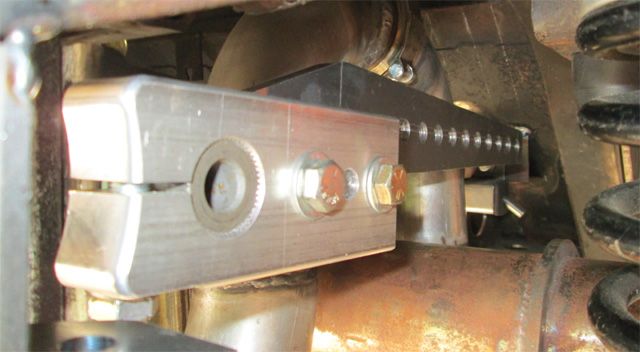

This shot is actually of the front bar, but it is essentially the same as the rear, just longer. I forgot to take a picture of the rear bar before bolting it in.

You can see how thick the aluminum arms are. They just wouldnít clear the frame and passenger side exhaust at the same time. The thinner steel arms will, but I will still need to put a small notch in the frame, since Iím not about to reroute the exhaust after all the work that went into it.
-
06-10-2017 01:06 PM #156
-
06-10-2017 05:12 PM #157
Thanks for the update(s), I'll have to take some time and study your pics. Always good ideas in there.
-
06-10-2017 06:25 PM #158
Thanks. I've got several more to post. I'll get more up ASAP. I've still got to shrink some of the pictures, but most of the writing is done.
-
06-10-2017 07:36 PM #159
It must be nice to make something and know it's good. Like the last set of wheel spacers I bought, checked Ebay of course, and no I'm not going to buy $30 spacers for a 30k truck. Went to Summit, coughed up $90 for a set and surprise surprise, Made in China.Seth
God cannot give us a happiness and peace apart from Himself, because it is not there. There is no such thing. C.S.Lewis
-
06-10-2017 07:59 PM #160
Yep, I know what you mean. I'm very thankful that I have been able to gather the tools I need to build this stuff. There's no way I could pay someone to do it for me.
-
06-10-2017 08:05 PM #161
The Watts link also needed some bracing in the fore/aft direction. This was something I knew from the beginning, but wanted to wait until everything else was added.
Another item Iíve been waiting to build was a trailer hitch. I have a small Mullins style trailer that I sometimes use for car shows since it allows me to carry a canopy, ice chest and a small gas grille. I pulled it everywhere when I drove the T-bucket. In that car, without the trailer, I would have been limited to not much more than a pack of chewing gum for cargo! At least the Healey has enough room for a suitcase or two, but I still want the option to pull the trailer.
I wanted the hitch to be hidden when not in use and I made most of it bolt in so that I could remove the gas tank. The hitch and Watts link bracing work together. The Watts brace transfers load back to a plate that supports the hitch. Any load on the plate is absorbed by the trailer hitch. This way any load on the Watts mounting plate ultimately is transmitted to the main chassis.
The Watts brace also serves to protect the fuel pump sump on the gas tank. I was concerned with it hanging down so far. I may add a small skid plate for even more protection.
I bought a spring loaded folding license plate mount off of EBAY. A rubber plug goes in the end of the receiver for the license plate to rest against. The receiver will be hidden behind the plate and most people will never know itís there if they donít get on their knees and look.
The tubing cross bar is not connected to anything in this pic. Like the sway bar, I'm going to have to wait until the body is removed to add the frame connectors. They will drop down on either side of the tank and bolt to the hitch crossbar. I left the crossbar a lot longer than it needs to be. I'll trim it to length when the frame supports are added.
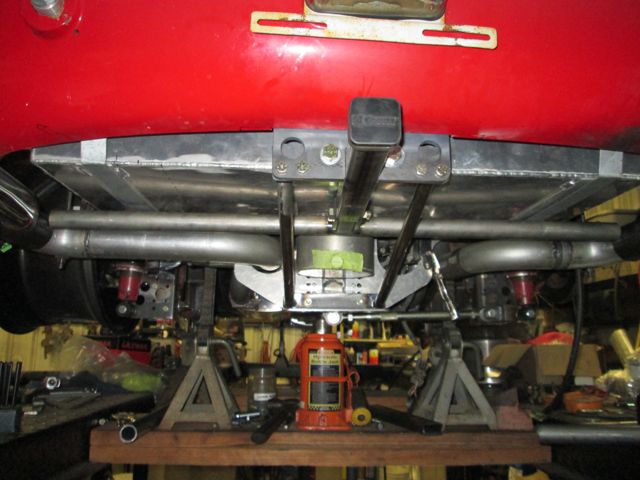
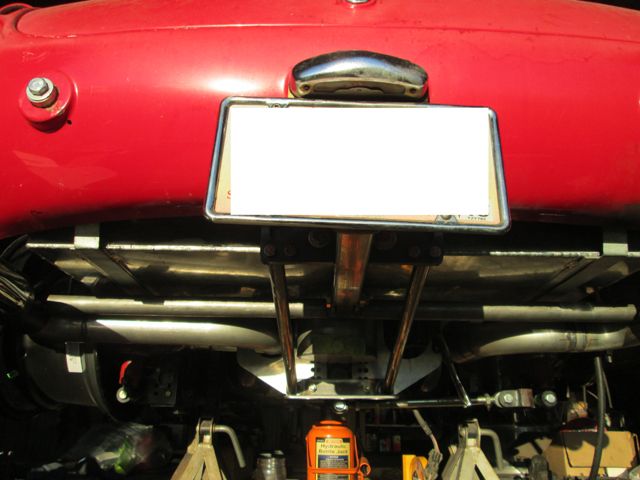
-
06-11-2017 06:52 PM #162
The last piece of the rear suspension puzzle is the auto leveling sensor for the air bags. Iím using a GM sensor off of a mid-90ís Cadillac, but GM used this sensor or very similar ones on many different high end cars in their line-up. This style of sensor has been used as far back as the 70ís at least, but there are a few differences between the early parts and later units that I know of. Mostly things like wire connections. There are some much smaller sensors on very late model cars, but they are part of GMís active suspension controls. I donít think they are stand alone units and require an external computer to do any work. The controls also need external relays, since the units donít have a lot of switching capacity.
I first attempted to use a GM system on my 46 Ford twenty years ago, but that attempt was a failure. I was trying do it on the cheap and use the GM compressor, but it wouldnít always succeed in airing up the aftermarket air shocks I was using. May have been a bad compressor or a mismatch with the shocks. I removed the system, added heavier springs and didnít try again until I built my T-bucket. That time I used just the sensor and combined it with an aftermarket compressor, small industrial valves, air bags instead of air shocks and my own wiring harness. That did the trick and the system worked perfectly for the 8 years that I drove that car. As far as I know itís still working for the fellow I sold the car to. The ride height was consistent no matter the load, so I always had all of the somewhat limited suspension travel that was available and even though it weighed less than 2000 lbs with me in it, it actually rode pretty good. My intention on this car is to use the air system in conjunction with coil overs for supplemental load support. This is similar to how these systems were used from the factory. Just like on my T-bucket, it will keep the ride height consistent and give me all the suspension travel that's available.
My part was off an independent suspension car, so I added a short piece to the original arm to make it about 1 1/2" longer. The sensors that came on cars with solid axles had longer arms from the factory. I'll be using ľĒ rod ends to connect the arm to the rear end. There is a small amount of adjustment where the arm attaches to the sensor, but the length of the link between the rearend and the arm can also be used to set ride height.

Here's where the sensor lives on a 90's era Cadillac. It's on the rear driver side.
The passenger side hole in the Watts brace worked out perfect as a location for the sensor. I was able to just rework the original GM bracket by cutting and welding. The bracket and arm don't have to be very heavy since the sensor moves very easy. I also had to bend the end of the arm for rearend clearance.
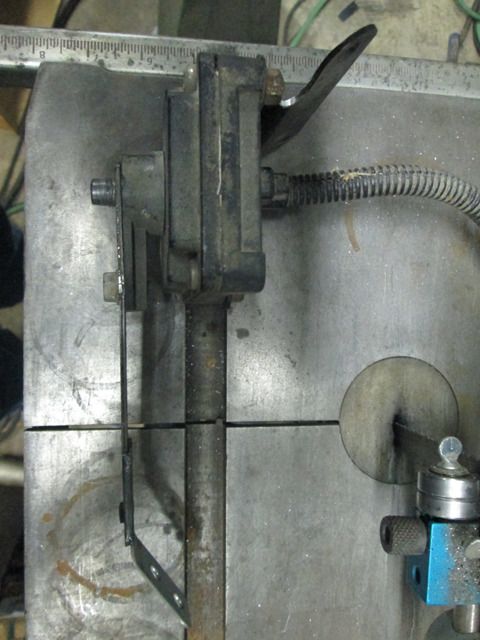
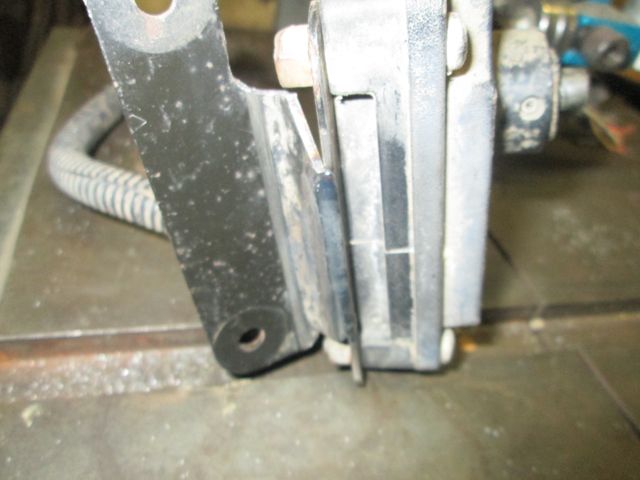
This is the sensor with the arm and bracket modified.
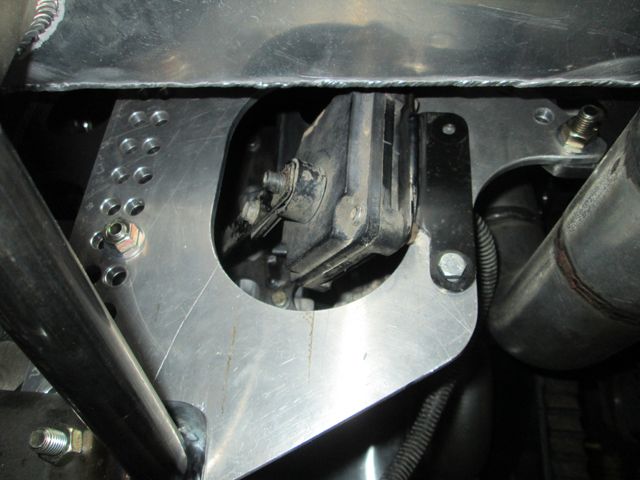
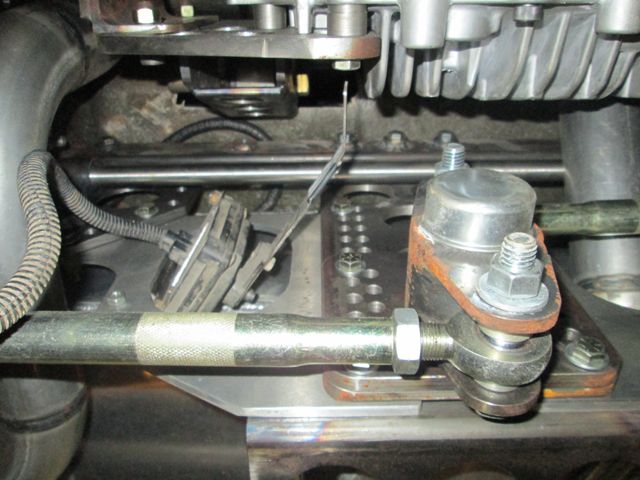
And here it is mounted on the car.
-
06-12-2017 12:23 PM #163
- Join Date
- Apr 2011
- Location
- Prairie City
- Car Year, Make, Model: 40 Ford Deluxe, 68 Corvette, 72&76 K30
- Posts
- 7,301
- Blog Entries
- 1
You're making great progress. Very nice tidy work and fab-ing pieces too.Ryan
1940 Ford Deluxe Tudor 354 Hemi 46RH Electric Blue w/multi-color flames, Ford 9" Residing in multiple pieces
1968 Corvette Coupe 5.9 Cummins Drag Car 11.43@130mph No stall leaving the line with 1250 rpm's and poor 2.2 60'
1972 Chevy K30 Longhorn P-pumped 24v Compound Turbos 47RH Just another money pit
1971 Camaro RS 5.3 BTR Stage 3 cam, SuperT10
Tire Sizes
-
06-12-2017 06:08 PM #164
Thanks 40. I would like to drive the car sometime this year, but it's going pretty slow. I won't rush it though.
-
06-12-2017 06:46 PM #165
Next up is the front sway bar. As I said I used a sprint car torsion bar here too. I had to wait until I actually had the wheel mounted, because I knew it was going to be a tight fit.
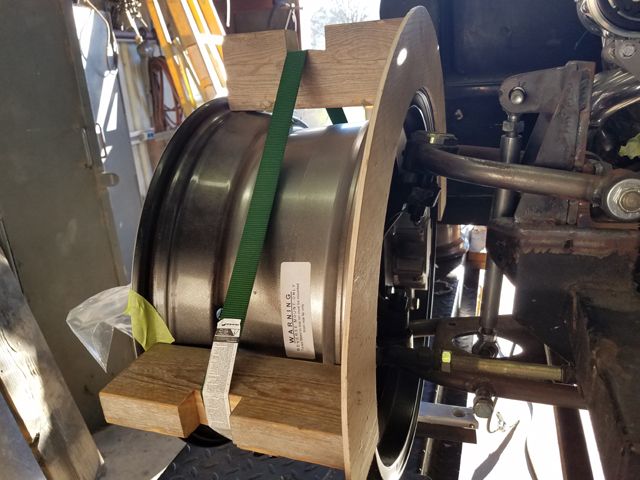
I made a crude wood mock up of the tire to check frame and sway bar clearance. I just clamp it around the rim with a ratchet strap. It looks like I will have to limit rack travel a little to keep the tires from rubbing on the frame. I get to that a little later. My mockup should simulate about a 255 width. I might just go with a 245 to keep from limiting rack travel too far.

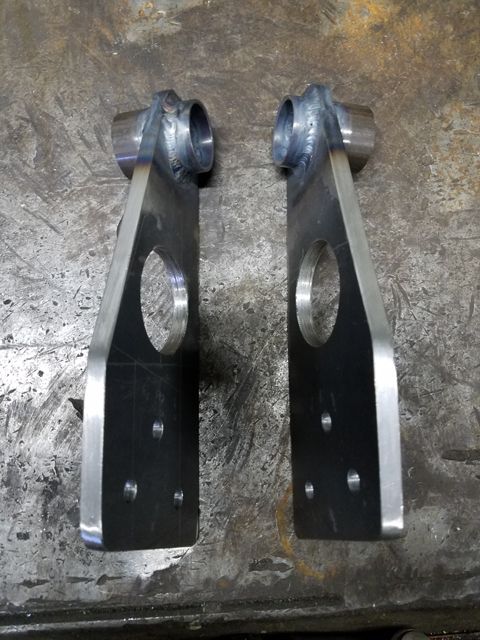
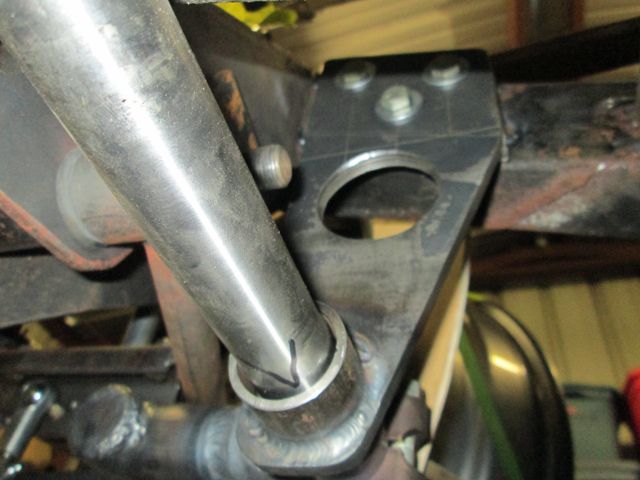
The bar supports had to drop a long way to get from the kicked up frame rail to the control arm. I had to go under the CA just to get some room for the adjustment that I wanted. I used the same type of Delrin bushings that are on the rear bar. I had intended to bolt the drop bracket directly to the frame rails, but the rails aren't exactly parallel and I had to add some small stand off brackets to the frame to get a good straight surface.
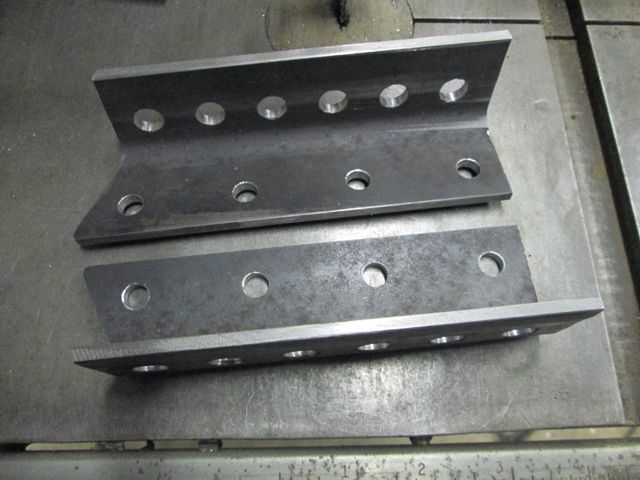
I also made a small angle bracket that bolts to the lower control arm for the links. There’s not as much adjustment in it as I would like, but it’s about all I could get.

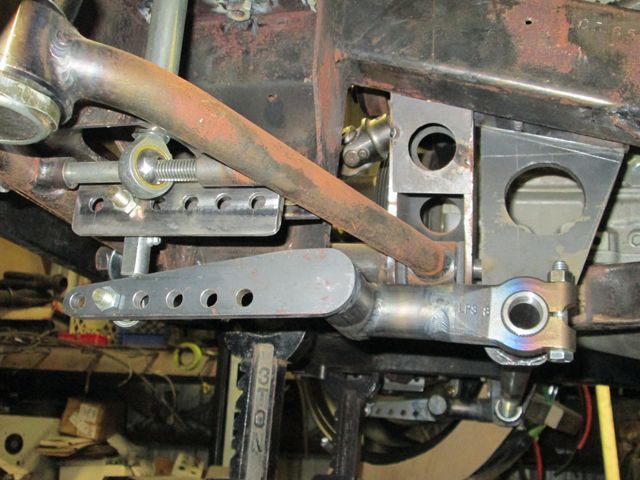
The arms for this bar have to take a pretty complicated path to get to the lower control arm. I also wanted to build in some rate adjustment just like in the rear. I suppose I could have heated and bent the aluminum arms, but wasn’t sure that I could make the tight bends with such a thick bar (1”). I switched over to a steel splined end that is made to attach to a tubular arm. I made a saddled joint and welded on a flat arm similar to the rear set up. Yes, these arms look very non-traditional, but they are strong, stiff, adjustable and more important, they clear everything and fit where they need to go.Last edited by Hotrod46; 06-12-2017 at 06:49 PM.




 1584Likes
1584Likes

 LinkBack URL
LinkBack URL About LinkBacks
About LinkBacks Reply With Quote
Reply With Quote


You guys may want to migrate to https://www.hotrodders.com/forums/projects-builds-my-ride.62/ this place seems to be hanging by a thread (pun intended). It's sad, forums are dying out, several of my...
Happy Thanksgiving!